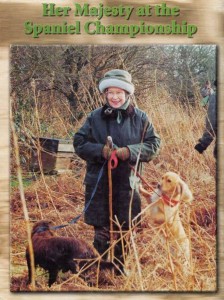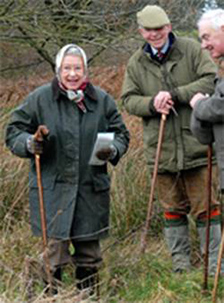“Cool It!!!”
(published in Spaniels In The Field – spring 2002 )
Something has been bothering me for quite some time and it seems like a good time to address the Spaniel readership on the issue. Please read the following scenarios and decide if something seems slightly amiss. 1) You are able to attend the Boston Marathon as an observer. Prior to the race you note the runners going through a strenuous series of gyrations on the ground and against stationary objects as they prepare themselves for their arduous task. After the race they are completely spent but continue to pace compulsively, gasping and unable to speak but constantly in motion. 2) Now you get to attend the Kentucky Derby. As the horses parade to the post they are slick with sweat, several actually in a lather as they load into the starting boxes. After the race the saddles are stripped off, the horses are bathed and paraded around by attentive grooms until they have completely dried off. 3) Now you go to a major spaniel field trial event. You watch as your favorite dog springs from his crate in the back of the handler’s vehicle, struts to the line, stands vibrating, waiting for his command and then is off in an explosion of activity. At the end of his brace, the dog flings himself into a nearby pond, trots back to the vehicle where the handler gives him a drink and loads him back in his crate. Why should our dogs’ muscles be different from other athletic species? The truth is, they’re not and I think we need to spend more time thinking about and acting on that fact. The human athlete always stretches and warms up prior to strenuous exercise. After an event a cool down period is very important, it is essential that he not just sit or lie down. To ignore these rules is to invite sports injuries and these rules apply equally to your canine athlete.
My observation is that many, or even most, athletic and working dogs go into competition or performance cold. No matter how well-conditioned the animal, muscles, joints and ligaments must have increased blood flow to reduce the potential for damage. Cold muscle fibers cannot elongate. In a “mind over matter” effort, the well-bred and trained dog responds to excitement and the adrenaline rush to exert his maximum effort in doing every task. Improperly prepared and warmed muscles must contract maximally and may possibly tear. Partial or complete ligament tears can seriously impact the dog’s future abilities and performance. I don’t mean to target the field trial people as my experience with hunters and racing greyhounds is similar. Racing greyhounds are rigidly controlled and must weigh in, sometimes hours before their race and are then held in crates in the “paddock” area. They are then led out, slowly walked about 1/8 of the way around the track, loaded into starting boxes and then fairly eject themselves out at top speed for their race. At the end, the good trainer may take them for a little walk, but more often they walk long enough to collect a urine sample and then back into the crate. Spaniels certainly get a better deal than that. Why do people and animals get delayed onset muscle soreness after muscle overuse? It is because cold muscle with less than optimal circulation that suddenly violently contracts experiences increased tissue pressure leading to localized lack of blood supply followed by structural damage such as small tears in the fibers, localized muscle inflammation and PAIN. Dogs are too frequently taken right from their crates to the line. This is a sharp contrast to equine competitions where the horses are warmed up extensively. In dressage competition, which is extremely demanding to all muscle groups, the top level competitors enter the ring with a sweat slick horse, ready to perform at its best. Nobody would think of pulling the horse from the stall, saddling it and entering the ring to compete. Dog’s work is certainly no easier.
The warm up period should be fairly easy, not taking more than 10 min. It should be strenuous enough to increase the temperature of the muscles by 2 degrees. This is reflected in a rise in rectal temperature of 1-2 degrees. (No, I definitely don’t expect you to run after the dog with a rectal thermometer, this is just an illustration. If anyone gets serious enough about my article and does this, PLEASE send me a photo!) This rise in temperature results in some panting and sweating in the athlete but we cannot use sweat as a guide in the dog. Some of this happens with the dog left in its crate, anxiously anticipating his opportunity to go but an active warm-up regimen is more advisable. This should not fatigue the dog but prepare the muscles and tendons for aerobic work (lasting more than 2 minutes.) The warm up activity should mimic the competitive activity but at a decreased intensity. When exercised in a cold condition, muscles use glycogen stores for energy, leading to lactic acid formation. Accumulation of lactic acid results in muscle stiffness and cramping. Warming up slowly decreases lactic acid buildup and glycogen depletion. The best insurance against muscle injuries is an active warm up. For ideas, you can use your imagination and the available terrain. Use the following guidelines;
1) Start with general movement, walk to trot to lope.
2) Trot the dog in circles, switching directions. This helps improve circulation to lateral muscles and the muscles along the sides of the spine. The first muscle group to fatigue in bird dogs is the back muscles and fatigue leads to soreness.
3) Hill work, if possible. This improves skill and coordination. Jog the dog up AND down a hill if available. If it is steep, just walk. This encourages stronger muscle contractions and active stretching.
4) Have the dog jump a few small jumps. This prepares the joints and also improves mental focus.
Excess warm up can cause fatigue. Take into consideration the ambient termperature, condition of the dog and event to be performed. In hot weather use a shorter easier warm up and cold weather calls for more vigorous work. The well-conditioned athlete takes longer and more strenuous work to reach optimal performance than one less well-conditioned. The effects of the warm up wear off quickly so it should be timed to end within a few minutes of performance. This allows recovery from temporary fatigue without losing the beneficial effects of the warm up. A dramatic statistic to keep in mind is that at rest, 15-20% of the animal’s blood flow supplies the skeletal muscle. After 10 min. of exercise, this increases to 70-75%. Not only are you giving your dog a healthier run, but you may start seeing your placements improve. Warm up has the most benefits in competitions that are high intensity and short duration such as sprinting and field trials. It will not have as dramatic effect in a long day of hunting but will certainly improve the health of your hunter’s musculoskeletal system. A warm up is documented to increase the speed of muscle contraction and relaxation, increase muscle strength and speed, improve swimming speed and running speed.
Another form of warm up is passive manipulation or stretching. Static stretching helps prevent and relieve delayed onset muscle soreness. This is especially beneficial to the old campaigner who has accumulated some wear and tear over the years. For the younger dog, it’s very relaxing and pleasant and helps create a strong bond with the handler. If active warm up isn’t possible, this is a great alternative, or can be used in addition to active work. The passive work does warm the muscles but does not significantly increase blood flow. Active warm up is best to improve circulation.
The following routine can be performed after competition as well. All these manipulations are intended for healthy, uninjured athletes. All stretches should be performed at least 15 sec at a time for 2-3 repetitions. Stretch to the point of resistance or tightness of a muscle and never to the point of pain. Keep stretches in a straight line and avoid rotating the involved joints. These manipulations can be done with the dog standing or lying on its side.
BACK LEG
1) Extend the back leg out behind with the stifle (knee) bent.
2) Keeping the stifle straight, bring the leg forward in a straight line with the body and guide the leg slightly under the dog’s belly. This stretches the hamstring.
3) Repeat the above maneuver with the stifle bent to stretch the gluteal muscles.
4) Repeat exercise 1 with the stifle fairly straight to flex the hip.
FRONT LEG
1) Flex the leg back with the elbow straight.
2) Extend the leg forward with the elbow bent.
3) Repeat 2 with the elbow straight.
4) Repeat 1 with the elbow bent.
Make sure you work both sides of the dog equally.
Finally, don’t forget the all important cool down. This is low intensity exercise such as walking that is performed early in the muscle recovery stage. It ensures the continued circulation of blood to muscles to help wash out metabolic byproducts of exercise (lactic acid) and dissipate heat. The ultimate outcome is a decrease in recovery time. The cool down should mirror the warm up. A short period of time jogging followed by a longer walk is appropriate. The time will be dependent on the type and intensity of exercise. Usually 10-20 min. minimum is necessary but some work may require an hour before the dog is cooled down completely. Abrupt cessation of exercise can temporarily decrease venous return to the heart and decrease coronary blood flow when the heart rate and oxygen demands of the heart muscle are high. When the brace is over, allow your dog to blow out and road slowly rather than replace him in his crate. Humans in this condition can experience angina pectoris, electrocardiographic abnormalities and pulse irregularities.
The benefits of cooling down include: return of heart rate and blood pressure to the resting level, increased venous return to the heart, increased heat loss and increased removal of lactic acid. In short, your dog will feel much better and undoubtedly run better the next day if called upon because he won’t be experiencing delayed onset muscle soreness.
Attention to warm up and cool down will not only help prevent injuries but also improve performance. Greater forces are necessary to injure a warm muscle than a cold one. Increased temperature causes vasodilation and greater blood saturation of the muscle and therefore maximum endurance performance. Increased oxygen and energy delivery to the muscle speeds removal of waste products. Let’s start treating these dogs like the athletes they are and you may be surprised how your small amount of time and effort reap significant rewards.
– ROBIN STRONK
Robin T. Stronk D.V.M. attended Cornell University. She is a member of the American Canine Sports Medicine Association. She and her husband, John, own two small animal practices in Brattleboro, VT and Hinsdale, NH. They enjoy hunting and the outdoors and own two English Springer Spaniels. “Chip” has proved to be an able assistant in the clinic.



